
Aegopodium podagraria, commonly called ground elder, is a species of flowering plant in the carrot family Apiaceae that grows in shady places. The name "ground elder" comes from the superficial similarity of its leaves and flowers to those of elder (Sambucus), which is not closely related. Other common names include herb gerard, bishop's weed, goutweed, gout wort, snow-in-the-mountain, English masterwort and wild masterwort. It is the type species of the genus Aegopodium. It is native to Europe and Asia, but has been introduced around the world as an ornamental plant, where it occasionally poses an ecological threat as an invasive exotic plant.
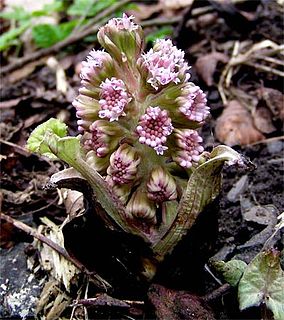
Petasites is a genus of flowering plants in the sunflower family, Asteraceae, that are commonly referred to as butterburs and coltsfoots. They are perennial plants with thick, creeping underground rhizomes and large rhubarb-like leaves during the growing season. Most species are native to Asia or southern Europe.

Colchicum autumnale, commonly known as autumn crocus, meadow saffron or naked ladies, is a toxic autumn-blooming flowering plant that resembles the true crocuses, but is a member of the plant family Colchicaceae, unlike the true crocuses which belong to the family Iridaceae. The name "naked ladies" comes from the fact that the flowers emerge from the ground long before the leaves appear. Despite the vernacular name of "meadow saffron", this plant is not the source of saffron, which is obtained from the saffron crocus, Crocus sativus – and that plant too is sometimes called "autumn crocus".

Anemonoides nemorosa, the wood anemone, is an early-spring flowering plant in the buttercup family Ranunculaceae, native to Europe. Other common names include windflower, thimbleweed, and smell fox, an allusion to the musky smell of the leaves. It is a perennial herbaceous plant growing 5–15 cm (2–6 in) tall.

Prunus cerasifera is a species of plum known by the common names cherry plum and myrobalan plum. It is native to Southeast Europe and Western Asia, and is naturalised in the British Isles and scattered locations in North America. Also naturalized in parts of SE Australia where it is considered to be a mildly invasive weed of bushland near urban centers.
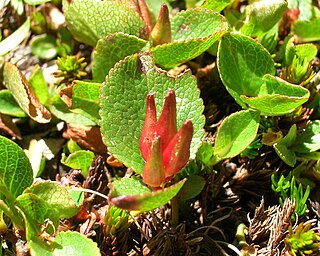
Salix herbacea, the dwarf willow, least willow or snowbed willow, is a species of tiny creeping willow adapted to survive in harsh arctic and subarctic environments. Distributed widely in alpine and arctic environments around the North Atlantic Ocean, it is one of the smallest of woody plants.

Myrrhis odorata, with common names cicely, sweet cicely, myrrh, garden myrrh, and sweet chervil, is a herbaceous perennial plant belonging to the celery family Apiaceae. It is the only species in the genus Myrrhis.
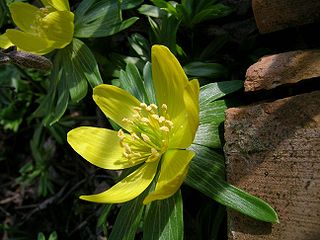
Eranthis hyemalis, the winter aconite, is a species of flowering plant in the buttercup family Ranunculaceae, native to calcareous woodland habitats in France, Italy and the Balkans, and widely naturalized elsewhere in Europe.

Silene dioica, known as red campion and red catchfly, is a herbaceous flowering plant in the family Caryophyllaceae, native throughout central, western and northern Europe, and locally in southern Europe. It has been introduced in Iceland, Canada, the US, and Argentina.

Scilla verna, commonly known as spring squill, is a flowering plant native to Western Europe. It belongs to the squill genus Scilla. Its star-like blue flowers are produced during the spring.

Myosotis sylvatica, the wood forget-me-not or woodland forget-me-not, is a species of flowering plant in the family Boraginaceae, native to Europe. This spring-flowering plant and its cultivars, typically with blue flowers, are the familiar forget-me-nots of gardens.

Lysichiton americanus, also called western skunk cabbage (US), yellow skunk cabbage (UK), American skunk-cabbage or swamp lantern, is a plant found in swamps and wet woods, along streams and in other wet areas of the Pacific Northwest, where it is one of the few native species in the arum family. The plant is called skunk cabbage because of the distinctive "skunky" odor that it emits when it blooms. This odor will permeate the area where the plant grows, and can be detected even in old, dried specimens. The distinctive odor attracts its pollinators, scavenging flies and beetles. Although similarly named and with a similar smell, the plant is easy to distinguish from the eastern skunk cabbage, another species in the arum family found in eastern North America.

Cardamine flexuosa, commonly known as wavy bittercress or wood bitter-cress, is an herbaceous annual, biennial, or short-lived perennial plant in the cabbage family (Brassicaceae).

Succisa pratensis, also known as devil's-bit or devil's-bit scabious, is a flowering plant in the honeysuckle family Caprifoliaceae. It differs from other similar species in that it has four-lobed flowers, whereas small scabious and field scabious have five lobes and hence it has been placed in a separate genus in the same family. It also grows on damper ground.
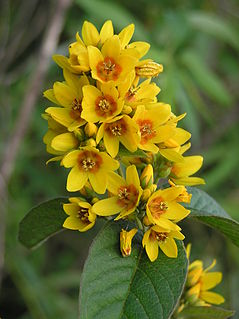
Lysimachia vulgaris, the yellow loosestrife or garden loosestrife, is a species of herbaceous perennial flowering plants in the family Primulaceae. It is native to wetlands, damp meadows and forests of south-east Europe. It is a tall plant with an upright habit, 50–150 centimetres (20–59 in) high, with erect panicles of conspicuous yellow flowers. The edges of the petals lack the fringe of hairs seen in L. punctata, and the hairy sepals have a conspicuous orange margin. It is in bloom from June through August in the British Isles. The leaves are opposite, ovate to lanceolate and spotted with translucent orange glands. L. vulgaris spreads by rhizomes, forming extensive patches and is sometimes considered invasive outside of its native range. In Australia growers have now successfully propagated and started growing the white variety in January in Tasmania.

Cirsium heterophyllum, the melancholy thistle, is an erect spineless herbaceous perennial flowering plant in the sunflower family Asteraceae. It is native to Europe and western Asia, where it grows in upland meadows, grasslands, road verges and open woodland.
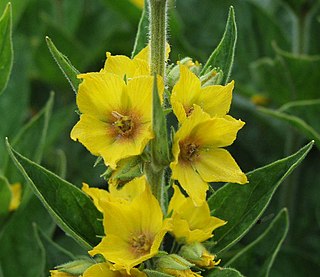
Lysimachia punctata, the dotted loosestrife, large yellow loosestrife, circle flower, or spotted loosestrife, is a flowering plant species in the family Primulaceae.
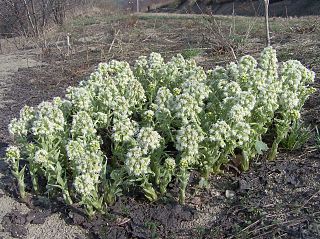
Petasites albus, the white butterbur, is a flowering plant species in the daisy family Asteraceae. It is native to central Europe and the Caucasus.
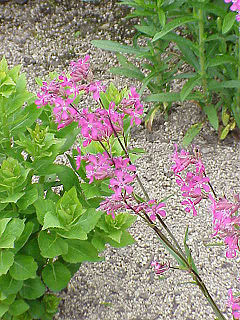
Viscaria vulgaris, the sticky catchfly or clammy campion, is a flowering plant in the family Caryophyllaceae.
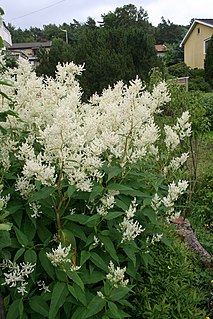
Koenigia × fennica, known as Finnish knotweed, is a hybrid between two species of Koenigia, K. alpina and K. weyrichii, members of the family Polygonaceae, the knotweed family. It generally only known as a cultivated garden plant, but plants have been recorded a few times surviving in abandoned areas in northern Europe, especially in Finland. The cultivar 'Johanniswolke' is considered an attractive ornamental perennial plant.




















